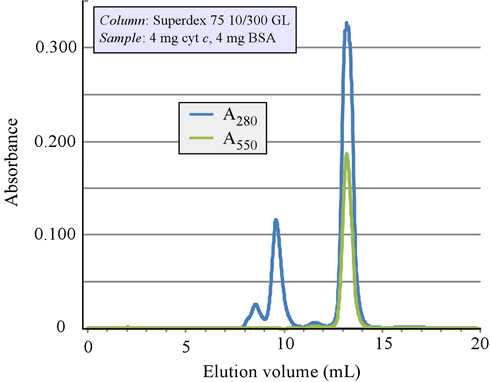BIOCHEMISTRY TOPICS
Chromatography
Size-exclusion chromatography
One of the most important applications of chromatography in biochemistry is size-exclusion chromatography. Size-exclusion chromatography is also called “gel filtration”, “molecular sieve” or "molecular exclusion" chromatography. Size-exclusion chromatography separates molecules according to size and shape. The dominant factor in determining retention time is size. For molecules that are within a more restricted range of sizes, the dependence on shape since is an important factor to consider.

The images at left, show a size exclusion chromatography column, the "Superdex 75" analytical scale, in action. Below is shown the corresponding chromatogram. The column stationary phase is made up of tiny (13 µm) spheres of high molecular mass carbohydrate polymer. The aqueous mobile phase is 50 mM sodium phosphate, pH 7.0 with 150 mM NaCl. The sample loaded onto the column contained a mixture of two proteins, cytochrome c (12.33 kD) and bovine serum albumin (BSA, 67 kD). The cytochrome c band is visible due to strong absorption at 550 nm, and appears as a deep red color. In (a), it is early in the run, and the sample has just begun to migrate in the column. Photo (b) was taken late in the run, and suggests that bands spread during a run. This shows up as peak broadening in the chromatogram. We discuss the theoretical reasons for band spreading below.

Concepts and applications in size-exclusion chromatography
The retention volume of an analyte species is the volume of mobile phase that has passed through the column when the peak of elution occurs. Void volume (V0) is the volume of the mobile phase in the column outside the stationary phase (ECA4, p.517). Size-exclusion chromatography is widely used to estimate the native molecular mass of proteins. Ideally, there is a linear relationship between the logarithm of a protein's molecular mass and its retention volume.